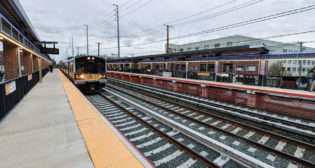
AquaTrack blasting away leaves on NJ Transit
Written by William C. Vantuono, Editor-in-ChiefThe fall foliage that bursts forth in the Northeastern United States is a beautiful thing to see—except when the leaves collect on railroad tracks, creating wheel slippage problems. That’s when NJ Transit deploys its AquaTrack machine to remove oily residue from fallen leaves and combat wheel slippage.
Basically an ultra-high-pressure power washer on railroad wheels, the AquaTrack has been in use by NJ Transit since October 2003. It consists of twin 250-hp diesel-engine units mounted on a flat car with an operator control cab, and one or more water tank cars. Two pressure pumps dispense water at up to 20,000 PSI directly to the top of the rail. The process uses 17 GPM (gallons per minute). The machine is propelled by a locomotive. Carolina Equipment & Supply Co. of North Charleston, S.C., developed the AquaTrack system.
 Fallen leaves on railhead surfaces are a problem facing all railroads in the Northeast and other parts of the world where deciduous trees are prevalent. The decaying leaves create an oily residue that coats the rails and causes poor wheel/rail adhesion, and thus poor traction. The decreased train speeds, in turn, create delays. Excessive wheel slippage also can create flat spots on wheel treads, burn spots on the rails, and in extreme conditions, metal-fatigue-induced rail and/or wheel shelling, spalling and cracking.
Fallen leaves on railhead surfaces are a problem facing all railroads in the Northeast and other parts of the world where deciduous trees are prevalent. The decaying leaves create an oily residue that coats the rails and causes poor wheel/rail adhesion, and thus poor traction. The decreased train speeds, in turn, create delays. Excessive wheel slippage also can create flat spots on wheel treads, burn spots on the rails, and in extreme conditions, metal-fatigue-induced rail and/or wheel shelling, spalling and cracking.
NJT’s leaf clearing operation runs from mid-October through mid-December. For 2015, AquaTrack will begin working on the Morris & Essex lines where, because of the line’s relatively steep grades, there have been instances of leaf-slippage delays in recent weeks, particularly for trains operating into Summit Station. Once that cleaning cycle for AquaTrack is complete, the unit will resume its regular fall schedule. AquaTrack operates primarily on the M&E and Montclair-Boonton lines, washing the rails twice a day Monday through Friday—once overnight and again during midday hours. On weekends, the Pascack Valley and Main/Bergen County lines are usually covered. In addition to AquaTrack, NJT also strategically spreads sand on the rails in advance of peak-period trains to increase traction. Plus, trees are trimmed to help stem the amount of leaves on the tracks.
“While we have learned time and again that there’s no all-inclusive way to prepare for how each change of season will impact our system, we’ve found great success with the AquaTrack unit in prior years when it comes to managing leaf-related slippage on our rails,” said NJT Executive Director Ronnie Hakim. “By utilizing this highly specialized equipment, we can keep the rails free and clear of fallen leaves, which increases safety and keep trains running on time.”
Click HERE to see a video of AquaTrack in action.



